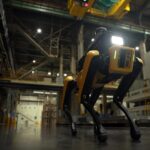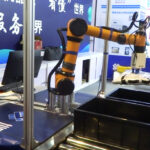ASIA ELECTRONICS INDUSTRYYOUR WINDOW TO SMART MANUFACTURING
Hyundai Motor Sketches Out Vision for MetaMobility
As cars of today are going digital, the line between vehicles and robots are getting so blurring that both of the two technologies are even crossing over each other’s areas.
This helps explain why car maker Hyundai Motor of Korea acquired Boston Robotics, a maker of dog-shaped and four-legged Robots known as Spot.
At a press conference held in Las Vegas on Jan. 5, Euisun Chung, executive chair with Hyundai Motor Group said, “It’s natural for us as a smart mobility company to think about robotics. This technology evolves and it is a natural extension of our mobility solution.”
Added he, “That’s why our mobility devices and service will all include robot functionality. That’s because mobility and robots work well and play together. They naturally complement each other. Mobility technology will accelerate robotics technology, and the vice versa, We are enriching our mobility services and products with this new robotics intelligence.’
Hyundai is betting on the technology crossover to create a new concept of mobility ecosystem in what’s called “Unlimited Mobility of Things”, allowing robotics to create a horizontal connection across all of Hyundai’s business areas.
The concept is to enable people to move wherever they want to move around, be it a physical or virtual world in what’s called MetaMobility
At the center of the ecosystem are robots, which can unlimitedly move around wherever they want to go -even yet human-uncharted spaces -Mars.
Mobility of Things

At a video tease, Hyundai shows how robots can virtually guide human to move around meta-world like yet untouched terrain. Armed with a wealth of sensors, the tease shows, a 4-legged dog-shaped Spot robot lands on Mars and scan surface to collect real-time data and then create and brings up human into the meta-world to virtually move around in the same way that it is moving in physical Mars.
“The possibility of the metaverse is infinite. The metaverse will expand the world we live. From technology perspectives, combining robots with metaverse will have huge impacts. Our mobility solutions will be expanded into what we call as MetaMobility,” explained Chung.
His vision is to create a sort of meta-mobility robots that can move human and things beyond real world into new reality in the metaverse.
For example, car assembly line meta-mobility robots can bring up human engineers into the meta world to virtually cooperate to shoot troubles at the assembly lines.
Hyundai’s Plug & Drive, or PnD mobility module is another exemplary concept of Mobility of Things ecosystem. Coming equipped with intelligent steering, braking, in-wheel electric drive and suspension hardware, and LiaDar and camera system, this single wheel unit can be attached to objects like tables in an office. Taking advantage of well-equipped sensor system, the table can move at users’ command to where users want it to stay, or users can schedule the table to move at a preset time. Hyundai showcased a variety of use cases – one case in which a PnD module-attached slave pod ferries physically-disabled person, or elderlies on a bus stop up to a host bus when it arrives.
MetaMobility

Hyundai’s vision can’t be achieved by itself alone, however. Its subsidiary Boston Robotics will side by it to share together the vision to make it come true.
Marc Raibert, founder and chairman with Boston Robotics came to the stage to explain how his company will share Hyundai’s vision to create the Mobility of Things ecosystem.
He said that Hyundai ad Boston is a perfect fit for Mobility of Things ecosystem, as both of the two companies have their own expertise to complement each other.
“Hyundai and Boston Dynamics are a match made in heaven. Boston Dynamics is not only a robotics company, but also a mobility-driven robotics company making robots that can go, are intended to go anywhere on earth or even beyond.”
“Boston Dynamics has several hundred Spot robots that are being used around the world. Next year, we gonna to launch Stretch, which is a logistics robot for warehouses. It gonna be really important to scale the design, reliability and support of these robots. And scale sets at Hyundai in those areas is just immense, It is really good opportunity for the two companies to help eac other and work together and work to make future in the mobile robotics happen,” he added.
He stressed that their shared goal is make a next generation of robots not just one people see today and those both of the two companies are going to make tomorrow.
According to him, what Hyundai and Boston Dynamics are seeing looking into the future is the brave new world where people and machines work together in order to improve safety of people, improve productivity, broadly improve quality of life.
Wearable Robots Around Human Exoskeleton

Boston has a lot of technology building blocks on hand for that sort of companion robots. One of them is athletic intelligence that is the ability to balance to climb stairs and to move any kind of terrain. The technology also can do dexterous manipulation to handle objects in the world and also achieve situational awareness that can sue sensor to understand what’s happening around.
The technology can not only allow robots to operate in places where people operate, but also in places where people shouldn’t operate. The company has one use case where Spot robots are operating in still radiation-risky Chernobyl area. Coming outfitted with radiation sensors, the robots are mapping level of radiation without dispatching people to work there.
Looking forward, Boston Robotics plans to introduce advanced robotic technologies into a wide variety of mobility systems not only for cars, but also robot themselves as well as urban air mobility vehicles.
Ove the long-term, Hyundai and Boston plans to work on a totally different new breed of groundbreaking robot technology termed as direct human mobility.
The concept is wearable robots that human can wear around their exoskeletons such as vest. They can physically work very closely with human, protecting workers and taking much of workloads. In extreme cases, they can evolve into a super human that can lift very heavy loads beyond what a normal person can’t do.




